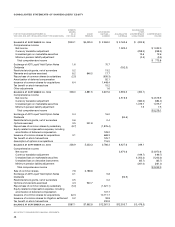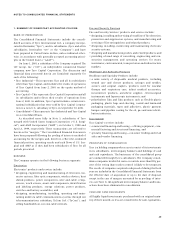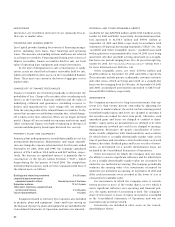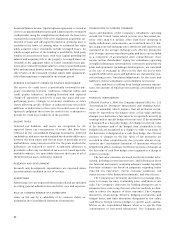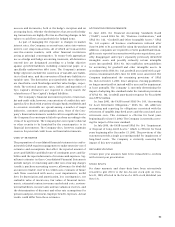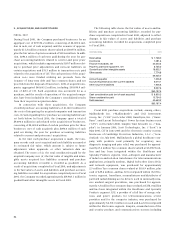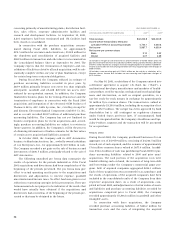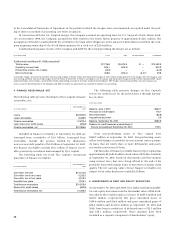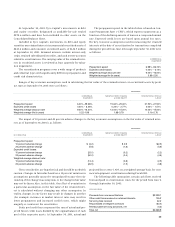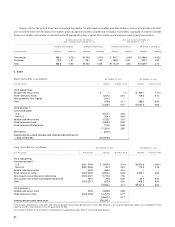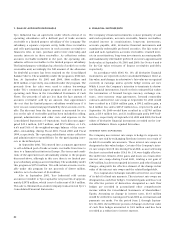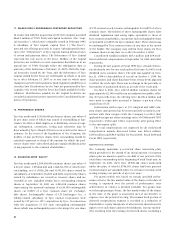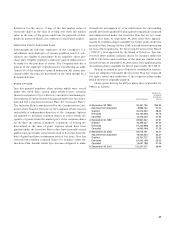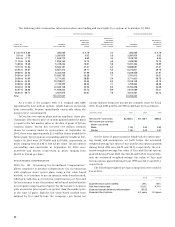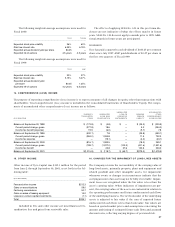ADT 2001 Annual Report Download - page 59
Download and view the complete annual report
Please find page 59 of the 2001 ADT annual report below. You can navigate through the pages in the report by either clicking on the pages listed below, or by using the keyword search tool below to find specific information within the annual report.
57
companies within our various business segments. Details regarding these purchase accounting liabilities are set forth below. During
Fiscal 2000, the Company spent a total of $4,790.7 million in cash related to the acquisition of businesses, consisting of $4,246.5 mil-
lion of purchase price (net of cash acquired) plus $544.2 million of cash paid out during Fiscal 2000 for purchase accounting liabili-
ties related to 2000 and prior years’ acquisitions.
The following table summarizes the purchase accounting liabilities recorded in connection with the Fiscal 2000 purchase
acquisitions:
SEVERANCE FACILITIES OTHER
NUMBER OF NUMBER OF
($ IN MILLIONS) EMPLOYEES RESERVE FACILITIES RESERVE RESERVE TOTAL
Original reserve established 7,215 $ 243.0 102 $ 87.6 $ 95.6 $ 426.2
Fiscal 2000 utilization (4,023) (146.2) (53) (34.3) (47.3) (227.8)
Fiscal 2001 utilization (4,962) (89.3) (65) (40.0) (36.9) (166.2)
Changes in estimates 3,537 35.6 64 36.4 31.7 103.7
Reversal to goodwill in Fiscal 2001 (515) (8.3) (9) (17.2) (7.8) (33.3)
Ending balance at September 30, 2001 1,252 $ 34.8 39 $ 32.5 $ 35.3 $ 102.6
Products segment, for net proceeds of approximately $74.4 mil-
lion in cash.
FISCAL 1999
During Fiscal 1999, the Company acquired companies for an
aggregate cost of $5,996.4 million, consisting of $4,546.8 million
in cash and the issuance of 32.4 million common shares valued
at $1,449.6 million. The cash portions of the acquisition costs
were funded utilizing cash on hand, the issuance of long-term
debt and borrowings under the Company’s commercial paper
program. Debt of acquired companies aggregated $926.9 million.
Each of these acquisitions was accounted for as a purchase, and
the results of operations of the acquired companies were
included in the consolidated results of the Company from their
respective acquisition dates. As a result of the acquisitions, the
Company recorded approximately $5,807.9 million in goodwill
and other intangible assets. At September 30, 2001, there
remained on the Consolidated Balance Sheet purchase account-
ing liabilities of $34.5 million for employee severance (princi-
pally for payments to employees already terminated), facility
related costs (principally for rents under non-cancelable leases
for vacated premises) and other costs.
3. POOLING OF INTERESTS TRANSACTIONS
During Fiscal 1999, subsidiaries of Tyco merged with U.S. Surgi-
cal and AMP. A total of approximately 118.4 million and
329.2 million Tyco common shares, respectively, were issued to
the former shareholders of these companies. Both these merger
transactions were accounted for under the pooling of interests
accounting method, which presents as a single interest common
shareholder interests that were previously independent. The
historical consolidated financial statements for periods prior to
the consummation of the mergers are restated as though the
companies had been combined during such periods.
Aggregate fees and expenses related to the mergers and to
the integration of the combined companies have been expensed
Purchase accounting liabilities recorded during Fiscal 2000
consist of $243.0 million for severance and related costs,
$87.6 million for costs associated with the shut down and consol-
idation of certain acquired facilities and $95.6 million for trans-
action and other direct costs. The $243.0 million of severance and
related costs covers employee termination benefits for approxi-
mately 7,215 employees located throughout the world, consisting
primarily of manufacturing and distribution employees to be ter-
minated as a result of the shut down and consolidation of pro-
duction facilities and, to a lesser extent, administrative, technical
and sales and marketing personnel. At September 30, 2001, 8,985
employees had been terminated and $34.8 million in severance
and related costs remained on the Consolidated Balance Sheet.
The Company expects that the remaining employee terminations
will be completed in Fiscal 2002.
The $87.6 million of exit costs are associated with the closure
and consolidation of 102 facilities located primarily in the Asia-
Pacific region and the United States. These facilities include
manufacturing plants, sales offices, corporate administrative
facilities and research and development facilities. Included
within these costs are accruals for non-cancelable leases associ-
ated with certain of these facilities. Approximately 118 facilities
had been closed or consolidated at September 30, 2001. The
remaining facilities are primarily small manufacturing plants,
which are expected to be shut down in Fiscal 2002. Expenses in
connection with the closure of these remaining facilities, as well
as the rental payments under non-cancelable leases (less any
expected sublease income for facilities already closed), comprise
the approximately $32.5 million for facility related costs remain-
ing on the Consolidated Balance Sheet at September 30, 2001.
During Fiscal 2001, the Company reduced its estimate of
purchase accounting liabilities relating primarily to Fiscal 2000
acquisitions by $33.3 million and, accordingly, goodwill and
related deferred tax assets were reduced by an equivalent
amount. These reductions resulted primarily from costs being
less than originally anticipated.
During Fiscal 2000, the Company sold certain of its
businesses, primarily within the Healthcare and Specialty



